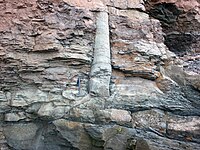
Photo from wikipedia
The coal-bearing sequences of Barakar and Raniganj formations exposed in Bina and Jhingurdah open-cast collieries, respectively, are analysed for their macro- and miofloral content. The sediment successions primarily comprise of… Click to show full abstract
The coal-bearing sequences of Barakar and Raniganj formations exposed in Bina and Jhingurdah open-cast collieries, respectively, are analysed for their macro- and miofloral content. The sediment successions primarily comprise of sandstones, shales, claystones and coal seams. In addition to the diverse glossopterid assemblage, four palynoassemblage zones, namely Zones I and II in Bina Colliery and Zones III and IV in Jhingurdah Colliery, have also been recorded in the present study. The megafossil assemblage from the Barakar strata of Bina Colliery comprises of three genera, namely Gangamopteris, Glossopteris and cf. Noeggerathiopsis. Palynoassemblage-I is characterised by the dominance of non-striate bisaccate pollen genus Scheuringipollenites and subdominance of striate bisaccate Faunipollenites and infers these strata to be of Early Permian (Artinskian) age (Lower Barakar Formation). The palynoassemblage has also yielded a large number of naked fossil spore tetrads, which is the first record of spore tetrads from any Artinskian strata in the world and has a significant bearing on the climatic conditions. The palynoassemblage-II is characterised with the dominance of Faunipollenites over Scheuringipollenites and is indicative of Kungurian age (Upper Barakar Formation). The megafossil assemblage from the Raniganj Formation of Jhingurdah Colliery comprises of five genera with 26 species representing four orders, viz., Equisetales, Cordaitales, Cycadales and Glossopteridales. The order Glossopteridales is highly diversified with 23 taxa and the genus Glossopteris, with 22 species, dominates the flora. The mioflora of this colliery is represented by two distinct palynoassemblages. The palynoassemblage-III is correlatable with the palynoflora of Early Permian (Artinskian) Lower Barakar Formation. The assemblage suggests the continuity of older biozones into the younger ones. The palynoassemblage-IV equates the beds with composition V: Striatopodocarpites–Faunipollenites–Gondisporites assemblage zone of Tiwari and Tripathi (1992) of Late Permian (Lopingian) Raniganj Formation in Damodar Basin. The FAD’s of Alisporites, Klausipollenites, Falcisporites, Arcuatipollenites pellucidus and Playfordiaspora cancellosa palynotaxa in this assemblage enhance the end Permian level of the Jhingurdah Top seam, as these elements are the key species to mark the transition of Permian into the Lower Triassic.
Journal Title: Journal of Earth System Science
Year Published: 2017
Link to full text (if available)
Share on Social Media: Sign Up to like & get
recommendations!